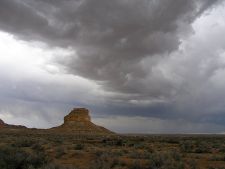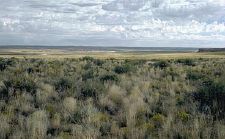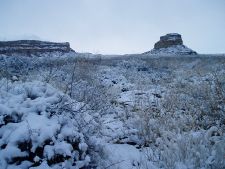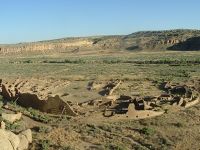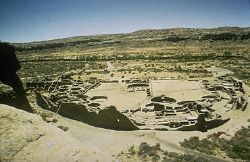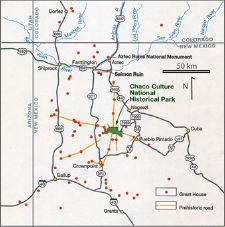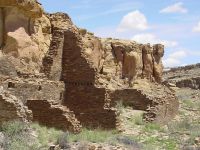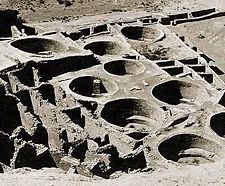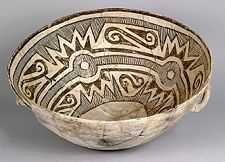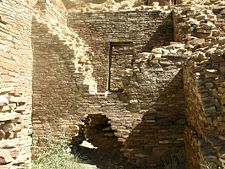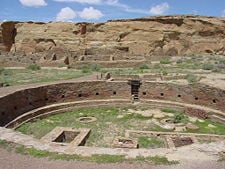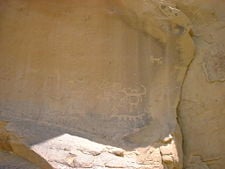Difference between revisions of "Chaco Culture National Historical Park" - New World Encyclopedia
Mary Anglin (talk | contribs) m |
Mary Anglin (talk | contribs) |
||
| Line 25: | Line 25: | ||
}} | }} | ||
| − | '''Chaco Culture National Historical Park''' is a [[United States]] [[National Historical Park]] and a [[UNESCO]] [[World Heritage Site]] hosting the densest and most exceptional concentration of [[pueblo]]s in the [[American Southwest]]. The 34,000-acre park is located in northwestern New Mexico, between [[Albuquerque, New Mexico|Albuquerque]] and [[Farmington, New Mexico|Farmington]], in a relatively inaccessible valley cut by the [[Chaco Wash]]. While we usually appreciate most U.S. National Parks for their present natural beauty, we appreciate Chaco for its mysterious past. Containing the most sweeping collection of ancient ruins north of Mexico, the park preserves one of America's most fascinating cultural and historic areas. | + | '''Chaco Culture National Historical Park''' is a [[United States]] [[National Historical Park]] and a [[UNESCO]] [[World Heritage Site]] hosting the densest and most exceptional concentration of [[pueblo]]s in the [[American Southwest]]. The 34,000-acre park is located in northwestern New Mexico, between [[Albuquerque, New Mexico|Albuquerque]] and [[Farmington, New Mexico|Farmington]], in a relatively inaccessible valley cut by the [[Chaco Wash]]. While we usually appreciate most U.S. National Parks for their present natural beauty, we appreciate Chaco for its mysterious past. Containing the most sweeping collection of ancient ruins north of Mexico, the park preserves one of America's most fascinating cultural and historic areas. |
| − | Between AD 900 and 1150, Chaco Canyon was a major center of culture for the [[Ancient Pueblo Peoples]]. | + | Between AD 900 and 1150, Chaco Canyon was a major center of culture for the [[Ancient Pueblo Peoples]]. Chacoans quarried sandstone blocks and hauled [[timber]] from great distances, assembling fifteen major complexes which remained the largest buildings in [[North America]] until the [[19th century]]. Evidence of [[archaeoastronomy]] at Chaco has been proposed, with the "Sun Dagger" [[petroglyph]] at [[Fajada Butte]] a popular example. Many Chacoan buildings were aligned to capture the solar and lunar cycles, requiring generations of astronomical observations and centuries of skillfully coordinated construction. [[Climate change]] is thought to have led to the emigration of Chacoans and the eventual abandonment of the canyon, beginning with a 50-year drought in 1130. |
| − | Located in the arid and inhospitable [[Four Corners (United States)|Four Corners]] region, the Chacoan cultural sites are fragile; fears of erosion caused by tourists have led to the closure of Fajada Butte to the public. The sites are considered sacred ancestral homelands of the [[Hopi]], [[Navajo people|Navajo]], and [[Pueblo people|Pueblo]] people, who continue to maintain [[oral tradition]]s recounting their historical migration from Chaco and their spiritual relationship to the land. | + | Located in the arid and inhospitable [[Four Corners (United States)|Four Corners]] region, the Chacoan cultural sites are fragile; fears of erosion caused by tourists have led to the closure of Fajada Butte to the public. The sites are considered sacred ancestral homelands of the [[Hopi]], [[Navajo people|Navajo]], and [[Pueblo people|Pueblo]] people, who continue to maintain [[oral tradition]]s recounting their historical migration from Chaco and their spiritual relationship to the land. While park preservation efforts conflict with native religious beliefs, tribal representatives work closely with the National Park Service to share their knowledge and respect the heritage of the Chacoan culture. |
== Geography == | == Geography == | ||
[[Image:Chaco Canyon Fajada Butte summer stormclouds.jpg|thumb|right|225px|Summer thunderstorms over [[Fajada Butte]] and the [[Fajada Gap]], near the southwestern rim of Chaco Canyon.]] | [[Image:Chaco Canyon Fajada Butte summer stormclouds.jpg|thumb|right|225px|Summer thunderstorms over [[Fajada Butte]] and the [[Fajada Gap]], near the southwestern rim of Chaco Canyon.]] | ||
| − | Chaco Canyon lies within the [[San Juan Basin]], atop the vast [[Colorado Plateau]], surrounded by the [[Chuska Mountains]] in the west, the [[San Juan Mountains]] to the north, and the [[San Pedro Mountains]] in the east. Ancient Chacoans relied upon their dense forests of [[oak]], [[pinyon pine|piñon]], [[Ponderosa Pine|ponderosa pine]], and [[juniper]] to obtain timber and other resources. The canyon itself, located within lowlands circumscribed by [[dune]] fields, ridges, and mountains, runs in a roughly northwest-to-southeast direction and is rimmed by flat [[massif]]s known as [[ | + | Chaco Canyon lies within the [[San Juan Basin]], atop the vast [[Colorado Plateau]], surrounded by the [[Chuska Mountains]] in the west, the [[San Juan Mountains]] to the north, and the [[San Pedro Mountains]] in the east. Ancient Chacoans relied upon their dense forests of [[oak]], [[pinyon pine|piñon]], [[Ponderosa Pine|ponderosa pine]], and [[juniper]] to obtain timber and other resources. The canyon itself, located within lowlands circumscribed by [[dune]] fields, ridges, and mountains, runs in a roughly northwest-to-southeast direction and is rimmed by flat [[massif]]s known as [[mesa]]s. Large gaps between the southwestern cliff faces (side canyons known as ''rincons'') were critical in funneling [[rain]]-bearing storms into the canyon, boosting local precipitation levels. The principal Chacoan complexes, such as [[Pueblo Bonito]], [[Nuevo Alto]], and [[Kin Kletso]], have elevations of 6,200 to 6,440 feet (1,890 to 1,963 m). |
| − | The [[alluvium|alluvial]] canyon floor, which slopes downward to the northeast at a gentle | + | The [[alluvium|alluvial]] canyon floor, which slopes downward to the northeast at a gentle grade of 30 feet per mile (6 meters per kilometer), is bisected by the Chaco Wash, an [[arroyo]] that only infrequently carries water. Of the canyon's [[aquifer]]s, the largest are located at a depth that precluded the ancient Chacoans from tapping their groundwater; only a few smaller, shallower sources supported small springs. Significant surface water is virtually non-existent except in the guise of storm runoff flowing intermittently through arroyos. |
=== Flora and fauna === | === Flora and fauna === | ||
| + | [[Image:Chaco Canyon roads.jpg|thumb|right|225px|Four ancient Anasazi roads dating from 900 C.E. to 1000 C.E. converge at Chaco Canyon.]] | ||
| − | Chaco Canyon's flora is typical of that found in the high deserts of North America: [[Artemisia tridentata|sagebrush]] and several species of [[cactus]] are interspersed with dry scrub forests of [[piñon]] and [[juniper]], the latter primarily on mesa tops. The canyon receives less precipitation than many other parts of New Mexico located at similar latitudes and elevations; consequently, it does not have the | + | Chaco Canyon's flora is typical of that found in the high deserts of North America: [[Artemisia tridentata|sagebrush]] and several species of [[cactus]] are interspersed with dry scrub forests of [[piñon]] and [[juniper]], the latter primarily on mesa tops. The canyon receives less precipitation than many other parts of [[New Mexico]] located at similar latitudes and elevations; consequently, it does not have the temperate coniferous forests that are plentiful in areas to the east. The prevailing sparseness of both plants and wildlife was echoed in ancient times, when overpopulation, expanding cultivation, overhunting, habitat destruction, and drought may have led the Chacoans to strip the canyon of wild plants and game. As such, even during wet periods, the canyon was only able to sustain around 2,000 people. |
| − | The canyon's most notable [[mammal]]ian species include the | + | The canyon's most notable [[mammal]]ian species include the [[coyote]], [[Mule Deer|mule deer]], [[elk]], and [[antelope]]. Important smaller [[carnivore]]s include the [[bobcat]]s, [[badger]]s, [[fox]]es, and two species of [[skunk]]. The park hosts abundant populations of [[rabbit]]s, [[porcupine]]s, [[rodent]]s—including several [[prairie dog]] towns—and small colonies of [[bat]]s, which are present during the summer. |
| + | |||
| + | The local shortage of water means that relatively few bird species are present; these include [[roadrunner]]s, large [[hawk]]s (such as [[Cooper's Hawk]]s and [[American Kestrel]]s), [[owl]]s, [[vulture]]s, and [[raven]]s, though they are less abundant in the canyon than in the wetter mountain ranges to the east. Sizeable populations of smaller birds, including warblers, sparrows, and house finches, are also common. Three species of [[hummingbird]]s are present, including the tiny, but highly pugnacious, [[Rufous Hummingbird]]; they compete intensely with the more mild-tempered [[Black-chinned Hummingbird]]s for breeding habitat in shrubs or trees located near water. [[Crotalus oreganus|Western (prairie) rattlesnake]]s are occasionally seen in the backcountry, though various [[lizard]]s and [[skink]]s are far more abundant. | ||
=== Climate === | === Climate === | ||
[[Image:Chaco Canyon Fajada Butte in snow NPS.jpg|thumb|right|225px|Fajada Butte in winter. An average of three or four snowstorms strike the canyon per year.]] | [[Image:Chaco Canyon Fajada Butte in snow NPS.jpg|thumb|right|225px|Fajada Butte in winter. An average of three or four snowstorms strike the canyon per year.]] | ||
| − | An arid region of high [[deserts and xeric shrublands|xeric scrubland]] and desert [[steppe]], the canyon and wider basin average 8 inches (20 cm) of rainfall annually; the park averages 9.1 inches (231.1 mm). Chaco Canyon lies on the [[windward and leeward|leeward]] side of extensive mountain ranges to the south and west, resulting in a [[rainshadow]] effect that leads to the prevailing lack of moisture in the region. | + | An arid region of high [[deserts and xeric shrublands|xeric scrubland]] and desert [[steppe]], the canyon and wider basin average 8 inches (20 cm) of rainfall annually; the park averages 9.1 inches (231.1 mm). Chaco Canyon lies on the [[windward and leeward|leeward]] side of extensive mountain ranges to the south and west, resulting in a [[rainshadow]] effect that leads to the prevailing lack of moisture in the region. Four distinct seasons define the region, with rainfall most likely between July and September; May and June are the driest months. [[Orographic precipitation]], resulting from moisture wrung out of storm systems ascending mountain ranges around Chaco Canyon, is responsible for most precipitation in both summer and winter; rainfall increases with higher elevation. Occasional abnormal northward excursions of the [[intertropical convergence zone]] may bring unusually high amounts of precipitation in some years. |
| − | |||
| − | |||
| + | The Chaco Canyon area is also characterized by remarkable climatic extremes: recorded temperatures range between −38 °F (−39 °C) to 102 °F (39 °C), and temperature swings of up to 60 °F in a single day are not unknown. The region averages less than 150 days without [[frost]] per year, and the local climate can swing wildly from years of plentiful rainfall to extended [[drought]]s. The heavy influence of the [[El Niño-Southern Oscillation]] phenomenon on the canyon's weather contributes to the extreme climatic variability. | ||
== Geology == | == Geology == | ||
| − | After the supercontinent of [[Pangaea]] split apart during the [[Cretaceous]] [[period (geology)|period]], the region became part of a shifting transition zone between a shallow inland sea—the [[Western Interior Seaway]]—and a band of plains and low hills to the west. A sandy and swampy coastline repeatedly shifted east and west, alternately submerging and uncovering the canyon's portion of what is now the Colorado Plateau. | + | After the supercontinent of [[Pangaea]] split apart during the [[Cretaceous]] [[period (geology)|period]], the region became part of a shifting transition zone between a shallow inland sea—the [[Western Interior Seaway]]—and a band of plains and low hills to the west. A sandy and swampy coastline repeatedly shifted east and west, alternately submerging and uncovering the canyon's portion of what is now the Colorado Plateau. |
| − | |||
| − | |||
| + | As the Chaco Wash flowed across the upper strata of what is now the 400-foot (122 m) [[Chacra Mesa]], it cut into it, gouging out the broad canyon over the course of millions of years. The mesa itself comprises [[sandstone]] and [[shale]] formations dating from the [[Late Cretaceous|late Cretaceous]], which are of the [[geologic formation|Mesa Verde formation. The canyon's bottomlands were later further eroded, exposing [[Menefee Shale]] [[bedrock]]; this was subsequently buried under approximately 125 feet (38 m) of deposited [[sediment]]. The canyon and mesa lie within the "Chaco Core," distinct from the wider Chaco Plateau; it is a relatively flat region of grassland with infrequent and interspersed stands of trees. Especially because the [[Continental Divide]] is only 15.5 miles (25 km) west of the canyon, geological characteristics and different patterns of drainage differentiate these two regions both from each other and from the nearby Chaco Slope, the Gobernador Slope, and the Chuska Valley. | ||
== History == | == History == | ||
| Line 63: | Line 64: | ||
[[Image:Anasazi-es.svg|thumb|right|225px|A map showing the extent of the ancient [[Anasazi]] civilization.]] | [[Image:Anasazi-es.svg|thumb|right|225px|A map showing the extent of the ancient [[Anasazi]] civilization.]] | ||
| − | Archaeologists identify the first people in the broader [[San Juan Basin]] as [[hunter-gatherer]]s designated as the [[Pecos Classification|Archaic]]; they in turn descended from nomadic [[Clovis culture|Clovis]] hunters who arrived in the Southwest around 10,000 B.C.E. | + | Archaeologists identify the first people in the broader [[San Juan Basin]] as [[hunter-gatherer]]s designated as the [[Pecos Classification|Archaic]]; they in turn descended from nomadic [[Clovis culture|Clovis]] hunters who arrived in the Southwest around 10,000 B.C.E. By approximately 900 B.C.E., these people lived at sites such as Atlatl Cave. The Archaic people left very little evidence of their presence in Chaco Canyon itself. However, by approximately AD 490, their descendants, designated as Basketmakers, were continuously farming within the canyon, living in Shabik'eshchee Village and other [[dugout (shelter)|pithouse]] settlements. |
| − | |||
| − | |||
| + | A small population of Basketmakers remained in the Chaco Canyon area and developed through several cultural stages until around 800, when they were building crescent-shaped stone complexes, each comprising four to five residential suites abutting subterranean [[kiva]]s, large enclosed areas set aside for religious observances and ceremonies. These structures have been identified as characteristic of the [[Pecos Classification|Early Pueblo People]]. By 850, the Pueblo population—also known as the "[[Anasazi]]," from a [[Navajo language|Navajo]] term meaning "ancient enemy"—had rapidly expanded, with members residing in larger, denser pueblos. There is strong evidence of a canyon-wide [[turquoise]] processing and trading industry dating from the 10th century. At this time, the first section of the massive [[Pueblo Bonito]] complex was built, beginning with a curved row of 50 rooms near its present north wall | ||
[[Image:Pueblo_Bonito_Aerial_Chaco_Canyon.jpg|thumb|left|200px|Pueblo Bonito, the largest of the Chacoan Great Houses, stands at the foot of Chaco Canyon's northern rim.]] | [[Image:Pueblo_Bonito_Aerial_Chaco_Canyon.jpg|thumb|left|200px|Pueblo Bonito, the largest of the Chacoan Great Houses, stands at the foot of Chaco Canyon's northern rim.]] | ||
| − | + | [[Image:Chaco canyon.jpg|thumb|left|250px|Pueblo Bonito, one of the principal complexes in the Chaco Canyon area.]] | |
| − | |||
| − | |||
| + | The cohesive system that characterized Chacoan society began disintegrating around 1140, perhaps in response to a severe 50-year [[drought]] that began in 1130; chronic climatic instability, including a series of severe droughts, again struck the region between 1250 and 1450. Other factors included water management patterns (leading to arroyo cutting) and deforestation. For instance, timber for construction was imported from outlying mountain ranges, such as the [[Chuska mountains|Chuska Mountains]] over 50 miles (80 km) to the west. Outlying communities began to disappear and, by the end of the century, the buildings in the central canyon had been carefully sealed and abandoned. Archaeological and cultural evidence leads scientists to believe people from this region migrated south, east, and west into the valleys and drainages of the [[Little Colorado River]], the [[Rio Puerco]], and the [[Rio Grande]]. | ||
=== Athabaskan succession === | === Athabaskan succession === | ||
| − | [[Numic]]-speaking peoples, such as the [[Ute tribe|Ute]] and [[Shoshone]], were present on the Colorado Plateau beginning in the 12th century. Nomadic [[Southern Athabaskan]] speaking peoples, such as the [[Apache]] and [[Navajo people|Navajo]], succeeded the Pueblo people in this region by the 15th century; in the process, they acquired Chacoan customs and agricultural skills. | + | [[Numic]]-speaking peoples, such as the [[Ute tribe|Ute]] and [[Shoshone]], were present on the Colorado Plateau beginning in the 12th century. Nomadic [[Southern Athabaskan]] speaking peoples, such as the [[Apache]] and [[Navajo people|Navajo]], succeeded the Pueblo people in this region by the 15th century; in the process, they acquired Chacoan customs and agricultural skills. Ute tribal groups also frequented the region, primarily during hunting and raiding expeditions. The modern Navajo Nation lies west of Chaco Canyon, and many Navajo (more appropriately known as the Diné) live in surrounding areas. The arrival of the [[Spanish Empire|Spanish]] in the 17th century inaugurated an era of subjugation and rebellion, with the Chaco Canyon area absorbing Puebloan and Navajo refugees fleeing Spanish rule. In succession, as first Mexico, then the U.S., gained sovereignty over the canyon, military campaigns were launched against the region's remaining inhabitants. |
=== Excavation and protection === | === Excavation and protection === | ||
[[Image:San Juan Basin Prehistoric Roads.jpg|thumb|right|225px|Prehistoric roads and Great Houses in the San Juan Basin.]] | [[Image:San Juan Basin Prehistoric Roads.jpg|thumb|right|225px|Prehistoric roads and Great Houses in the San Juan Basin.]] | ||
| − | The trader [[Josiah Gregg]] was, in 1832, the first to write about the ruins of Chaco Canyon, referring to Pueblo Bonito as "built of fine-grit sandstone." In 1849, a [[United States Army|U.S. Army]] detachment passed through and surveyed the ruins. | + | The trader [[Josiah Gregg]] was, in 1832, the first to write about the ruins of Chaco Canyon, referring to Pueblo Bonito as "built of fine-grit sandstone." In 1849, a [[United States Army|U.S. Army]] detachment passed through and surveyed the ruins. The location was so remote, however, that over the next 50 years the canyon was scarcely visited. After a brief reconnaissance by Smithsonian scholars in the 1870s, formal archaeological work began in 1896, when a party from the American Museum of Natural History (the Hyde Exploring Expedition) began excavating in Pueblo Bonito. They spent five summers in the region, sent over 60,000 artifacts back to New York, and operated a series of trading posts. |
| − | |||
| − | |||
| + | In 1901 [[Richard Wetherill]], who worked for the Hyde brothers and their expedition, claimed a [[Homestead Act|homestead]] of 161 [[acre]]s of land that included Pueblo Bonito, [[Pueblo del Arroyo]], and [[Chetro Ketl]] While investigating Wetherill's land claim, federal land agent Samuel J. Holsinger reported the physical setting of the canyon and the sites, noted prehistoric road segments and stairways above Chetro Ketl, and documented prehistoric dams and irrigation systems. His report (which went unpublished) strongly recommended the creation of a [[national park]] to encompass and preserve Chacoan sites. The next year, [[Edgar Lee Hewett]], who was president of New Mexico Normal University (which later became [[New Mexico Highlands University]]), mapped many Chacoan sites. Hewett and others helped to enact the Federal [[Antiquities Act|Antiquities Act of 1906]], which was the first U.S. law protecting antiquities; it was, in effect, a direct consequence of controversy surrounding Wetherill's activities in the Chaco Canyon area. The Act also allowed the [[President of the United States|President]] to establish [[U.S. National Monument|national monuments]]. President [[Theodore Roosevelt]] thus proclaimed Chaco Canyon National Monument on March 11, 1907; Wetherill relinquished his claim on several parcels of land he held in Chaco Canyon. | ||
[[Image:Chaco Canyon Hungo Pavi ruins staircase NPS.jpg|thumb|left|200px|The ruins of Hungo Pavi, located near the center of Chaco Canyon. A staircase leads out of the complex.]] | [[Image:Chaco Canyon Hungo Pavi ruins staircase NPS.jpg|thumb|left|200px|The ruins of Hungo Pavi, located near the center of Chaco Canyon. A staircase leads out of the complex.]] | ||
| − | In 1949, Chaco Canyon National Monument was expanded with lands deeded from the [[University of New Mexico]]. In return, the university maintained scientific research rights to the area. By 1959, the [[National Park Service]] had constructed a park visitor center, staff housing, and campgrounds. As a historic property of the National Park Service, the National Monument was listed on the [[National Register of Historic Places]] on October 15, 1966. In 1971, researchers Robert Lister and James Judge established the Chaco Center, a division for cultural research that functioned as a joint project between the University of New Mexico and the National Park Service. A number of multi-disciplinary research projects, archaeological surveys, and limited excavations began during this time. The Chaco Center extensively surveyed the Chacoan roads, well-constructed paths radiating from the central canyon. | + | In 1949, Chaco Canyon National Monument was expanded with lands deeded from the [[University of New Mexico]]. In return, the university maintained scientific research rights to the area. By 1959, the [[National Park Service]] had constructed a park visitor center, staff housing, and campgrounds. As a historic property of the National Park Service, the National Monument was listed on the [[National Register of Historic Places]] on October 15, 1966. In 1971, researchers Robert Lister and James Judge established the Chaco Center, a division for cultural research that functioned as a joint project between the University of New Mexico and the National Park Service. A number of multi-disciplinary research projects, archaeological surveys, and limited excavations began during this time. The Chaco Center extensively surveyed the Chacoan roads, well-constructed paths radiating from the central canyon. The results from such research conducted at Pueblo Alto and other sites dramatically altered accepted academic interpretations of both the Chacoan culture and the Four Corners region of the American Southwest. |
| − | The richness of the cultural remains at park sites led to the expansion of the small National Monument into the Chaco Culture National Historical Park on December 19, 1980, when an additional 13,000 acres (53 km²) were added to the protected area. In 1987, the park was designated a [[World Heritage Site]] by [[UNESCO]]. To safeguard Chacoan sites on adjacent [[Bureau of Land Management]] and [[Navajo Nation]] lands, the Park Service developed the multi-agency Chaco Culture Archaeological Protection Site program. These initiatives have detailed the presence of more than 2,400 archeological sites within the current park's boundaries; only a small percentage of these have been excavated. | + | The richness of the cultural remains at park sites led to the expansion of the small National Monument into the Chaco Culture National Historical Park on December 19, 1980, when an additional 13,000 acres (53 km²) were added to the protected area. In 1987, the park was designated a [[World Heritage Site]] by [[UNESCO]]. To safeguard Chacoan sites on adjacent [[Bureau of Land Management]] and [[Navajo Nation]] lands, the Park Service developed the multi-agency Chaco Culture Archaeological Protection Site program. These initiatives have detailed the presence of more than 2,400 archeological sites within the current park's boundaries; only a small percentage of these have been excavated. |
| − | |||
| − | |||
| − | |||
| − | |||
== Sites == | == Sites == | ||
| Line 103: | Line 97: | ||
=== Central canyon === | === Central canyon === | ||
| − | The central portion of the canyon contains the largest Chacoan complexes. The most studied is [[Pueblo Bonito]] ("Beautiful Village"); covering almost 2 acres (8,000 m²) and comprising at least 650 rooms, it is the largest Great House; in parts of the complex, the structure was four stories high. The builders' use of core-and-veneer architecture and multi-story construction necessitated massive masonry walls up to 3 feet (1 m) thick. Pueblo Bonito is divided into two sections by a wall precisely aligned to run north-south, bisecting the central plaza. A Great Kiva was placed on either side of the wall, creating a symmetrical pattern common to many Chacoan Great Houses. The complex, upon completion, was roughly the size of the [[Rome|Roman]] [[Colosseum]]. | + | The central portion of the canyon contains the largest Chacoan complexes. The most studied is [[Pueblo Bonito]] ("Beautiful Village"); covering almost 2 acres (8,000 m²) and comprising at least 650 rooms, it is the largest Great House; in parts of the complex, the structure was four stories high. The builders' use of core-and-veneer architecture and multi-story construction necessitated massive masonry walls up to 3 feet (1 m) thick. Pueblo Bonito is divided into two sections by a wall precisely aligned to run north-south, bisecting the central plaza. A Great Kiva was placed on either side of the wall, creating a symmetrical pattern common to many Chacoan Great Houses. The complex, upon completion, was roughly the size of the [[Rome|Roman]] [[Colosseum]]. |
| − | |||
| − | |||
| − | [[ | + | Nearby is [[Pueblo del Arroyo]]; founded between AD 1050 and 1075 and completed in the early 12th century, it is located near Pueblo Bonito at a drainage outlet known as South Gap. Casa Rinconada, hosting a Great Kiva and relatively isolated from other sites in Chaco Canyon, sits to the south side of Chaco Wash, adjacent to a Chacoan road leading to a set of steep stairs that reached the top of Chacra Mesa. The kiva stands alone, with no residential or support structures; it once had a 39-foot (12 m) passageway leading from the underground kiva to several above-ground levels. [[Chetro Ketl]], located near Pueblo Bonito, bears the typical D-shape of many other central complexes, but is slightly smaller. Begun between AD 1020 and 1050, its 450–550 rooms shared just one Great Kiva. Scientists estimate that it took 29,135 person-hours of construction to erect Chetro Ketl alone; Hewett estimated that it required the wood of 5,000 trees and 50 million stone blocks. |
| + | [[Kin Kletso]] ("Yellow House") was a medium-sized complex located 0.5 miles (0.8 km) west of Pueblo Bonito; it shows strong evidence of construction and occupation by Pueblo peoples from the northern San Juan Basin. Its rectangular shape and design is related to the Pueblo II cultural group, rather than the Pueblo III style or its Chacoan variant. It contains around 55 rooms, four ground-floor kivas, and a two-story cylindrical tower that may have functioned as a kiva or religious center. Evidence of an [[obsidian]] production industry was discovered near the village, which was erected between AD 1125 and 1130. | ||
[[Image:Bowl Chaco Culture NM USA.jpg|thumb|right|225px|A ceramic bowl excavated from Pueblo Alto, dating from AD 1030 to 1200.]] | [[Image:Bowl Chaco Culture NM USA.jpg|thumb|right|225px|A ceramic bowl excavated from Pueblo Alto, dating from AD 1030 to 1200.]] | ||
| − | |||
| − | [[Pueblo Alto]], a Great House of 89 rooms, is located on a mesa top near the middle of Chaco Canyon, and is 0.6 miles (1 km) from Pueblo Bonito; it was begun between AD 1020 and 1050 during a wider building boom throughout the canyon. Its location made the community visible to most of the inhabitants of the San Juan Basin; indeed, it was only 2.3 miles (3.7 km) north of Tsin Kletsin, on the opposite side of the canyon. The community was the center of a [[bead]]- and [[turquoise]]-processing industry that influenced the development of all villages in the canyon; [[chert]] tool production was also common. Research conducted by archaeologist Tom Windes at the site suggests that only a handful of families, perhaps as few as five to twenty, actually lived in the complex; this may imply that Pueblo Alto served a primarily non-residential role. | + | [[Pueblo Alto]], a Great House of 89 rooms, is located on a mesa top near the middle of Chaco Canyon, and is 0.6 miles (1 km) from Pueblo Bonito; it was begun between AD 1020 and 1050 during a wider building boom throughout the canyon. Its location made the community visible to most of the inhabitants of the San Juan Basin; indeed, it was only 2.3 miles (3.7 km) north of Tsin Kletsin, on the opposite side of the canyon. The community was the center of a [[bead]]- and [[turquoise]]-processing industry that influenced the development of all villages in the canyon; [[chert]] tool production was also common. Research conducted by archaeologist Tom Windes at the site suggests that only a handful of families, perhaps as few as five to twenty, actually lived in the complex; this may imply that Pueblo Alto served a primarily non-residential role. Another Great House, [[Nuevo Alto]], was built on the north mesa near Pueblo Alto; it was founded in the late 1100s, a time when the Chacoan population was declining in the canyon. |
=== Outliers === | === Outliers === | ||
| − | In Chaco Canyon's northern reaches lies another cluster of Great Houses; among the largest are [[Casa Chiquita]] ("Small House"), a village built in the 1080s AD, when, in a period of ample rainfall, Chacoan culture was expanding. Its layout featured a smaller, squarer profile; it also lacked the open plazas and separate kivas of its predecessors. | + | In Chaco Canyon's northern reaches lies another cluster of Great Houses; among the largest are [[Casa Chiquita]] ("Small House"), a village built in the 1080s AD, when, in a period of ample rainfall, Chacoan culture was expanding. Its layout featured a smaller, squarer profile; it also lacked the open plazas and separate kivas of its predecessors. Larger, squarer blocks of stone were used in the masonry; kivas were designed in the northern [[Mesa Verde]]an tradition. Two miles down the canyon is [[Peñasco Blanco]] ("White Bluff"), an arc-shaped compound built atop the canyon's southern rim in five distinct stages between AD 900 and 1125. A cliff painting (the "Supernova Platograph") nearby may record the sighting of the [[SN 1054]] [[supernova]] on July 5, 1054. |
| − | [[Hungo Pavi]], located just 1 mile (2 km) from Una Vida, measured 872 feet (266 m) in circumference. Initial explorations revealed 72 ground-level rooms, | + | [[Hungo Pavi]], located just 1 mile (2 km) from Una Vida, measured 872 feet (266 m) in circumference. Initial explorations revealed 72 ground-level rooms, with structures reaching four stories in height; one large circular kiva has been identified. [[Kin Nahasbas]] (built in either the 9th or 10th century) was another major ruin; it is located slightly north of Una Vida, positioned at the foot of the north mesa. Limited excavation has been conducted in this area. |
[[Image:Chaco Canyon Wijiji interior NASA.jpg|thumb|right|225px|An interior view of [[Wijiji]], an outlier complex occupied between AD 1100 and 1150.]] | [[Image:Chaco Canyon Wijiji interior NASA.jpg|thumb|right|225px|An interior view of [[Wijiji]], an outlier complex occupied between AD 1100 and 1150.]] | ||
| − | [[Tsin Kletzin]] ("Charcoal Place"), a compound located on the Chacra Mesa and positioned above Casa Rinconada, is 2.3 miles (3.7 km) due south of Pueblo Alto, on the opposite side of the canyon. It lies near Weritos Dam, a massive earthen structure that scientists believe provided Tsin Kletzin with all of its domestic water. The dam worked by retaining stormwater runoff in a reservoir. However, massive amounts of silt accumulated during flash floods would have forced the residents to regularly rebuild the dam and dredge the catchment area. | + | [[Tsin Kletzin]] ("Charcoal Place"), a compound located on the Chacra Mesa and positioned above Casa Rinconada, is 2.3 miles (3.7 km) due south of Pueblo Alto, on the opposite side of the canyon. It lies near Weritos Dam, a massive earthen structure that scientists believe provided Tsin Kletzin with all of its domestic water. The dam worked by retaining stormwater runoff in a reservoir. However, massive amounts of silt accumulated during flash floods would have forced the residents to regularly rebuild the dam and dredge the catchment area. |
| − | Deeper into the canyon, [[Una Vida]] ("One Life") is one of the three earliest Great Houses with construction beginning around AD 900. Comprising at least two stories and 124 rooms, | + | Deeper into the canyon, [[Una Vida]] ("One Life") is one of the three earliest Great Houses with construction beginning around AD 900. Comprising at least two stories and 124 rooms, it shares an arc or D-shaped design with its contemporaries, Peñasco Blanco and Pueblo Bonito, but has a unique "dog leg" addition made necessary by topography. It is located in one of the canyon's major side drainages, near Gallo Wash, and was massively expanded after 930. [[Wijiji]] ("[[Greasewood]]"), comprising just over 100 rooms, is the smallest of the Great Houses. Built between AD 1110 and 1115, it was the last Chacoan Great House to be constructed. Somewhat isolated within the narrow wash, it is positioned 1 mile (2 km) from neighboring Una Vida. |
| − | Directly north are communities that are even more remote, including [[Salmon Ruins]] and [[Aztec Ruins]], which are located along the [[San Juan River (Utah)|San Juan]] and [[Animas River]]s near Farmington; these were built during a 30-year wet period that began in AD 1100. | + | Directly north are communities that are even more remote, including [[Salmon Ruins]] and [[Aztec Ruins]], which are located along the [[San Juan River (Utah)|San Juan]] and [[Animas River]]s near Farmington; these were built during a 30-year wet period that began in AD 1100. Sixty miles (100 km) directly south of Chaco Canyon, on the [[Great South Road]], lies another cluster of outlying communities. The largest of these is Kin Nizhoni, which stands atop a 7,000 foot (2,100 m) mesa surrounded by marsh-like bottomlands. |
== Ruins == | == Ruins == | ||
| Line 132: | Line 124: | ||
[[Image:Chaco Canyon Chetro Ketl great kiva plaza NPS.jpg|thumb|right|225px|The Great Kiva of Chetro Ketl, one of the Chacoan Great Houses.]] | [[Image:Chaco Canyon Chetro Ketl great kiva plaza NPS.jpg|thumb|right|225px|The Great Kiva of Chetro Ketl, one of the Chacoan Great Houses.]] | ||
| − | Immense complexes known as "Great Houses" were key centers exemplifying Chacoan architectural and worship styles. Although forms evolved as the centuries passed, the houses maintained several core characteristics. Most notable is their sheer bulk; most complexes in Chaco Canyon averaged more than 200 rooms each, with some reaching up to 700 rooms. | + | Immense complexes known as "Great Houses" were key centers exemplifying Chacoan architectural and worship styles. Although forms evolved as the centuries passed, the houses maintained several core characteristics. Most notable is their sheer bulk; most complexes in Chaco Canyon averaged more than 200 rooms each, with some reaching up to 700 rooms. The sizes of individual rooms were also substantial, with high ceilings when compared to buildings erected in preceding Anasazi periods. They were also well-planned, with vast sections or wings erected in a single stage, rather than in increments. Houses are generally oriented to face the south, with plaza areas almost always enclosed by edifices of sealed-off rooms or high walls. The predominantly multistory constructions often stood four to five stories tall, with single-story rooms facing directly onto the plaza; room blocks were terraced so that the tallest sections composed the pueblo's rear edifice. Rooms were often organized into suites, with front rooms larger than rear, interior, and storage rooms or areas. |
| − | |||
| − | |||
| + | Ceremonial structures known as [[kiva]]s were built in proportion to the number of rooms in a pueblo. On average, one small kiva was built for every 29 rooms. Nine complexes also each hosted an oversized Great Kiva, which could range up to 63 feet (19 m) in diameter. All Chacoan kivas share distinctive architectural features, including T-shaped doorways and stone [[lintel]]s. Though simple and compounds walls were also built, Great Houses were primarily constructed of [[core-and-veneer]] walls: two parallel load-bearing walls comprising dressed, flat [[sandstone]] blocks bound in [[clay]] mortar were erected. The gap between the walls was filled with [[rubble]], which then formed the wall's core. Walls were then covered in a veneer of small sandstone pieces, which were pressed into a layer of binding [[mud]]. These surfacing stones were often placed to create distinctive patterns. Taken together, the Chacoan constructions required the wood of over 200,000 coniferous trees, which were mostly hauled—on foot—from mountain ranges up to 70 miles (113 km) away. | ||
=== Usage === | === Usage === | ||
[[Image:Chaco Canyon Una Vida petroglyphs NPS.jpg|thumb|right|225px|Chacoan petroglyphs frequently exhibit key mythological symbolism and knowledge of celestial events. Shown here are examples near Una Vida.]] | [[Image:Chaco Canyon Una Vida petroglyphs NPS.jpg|thumb|right|225px|Chacoan petroglyphs frequently exhibit key mythological symbolism and knowledge of celestial events. Shown here are examples near Una Vida.]] | ||
| − | |||
| − | The meticulously designed buildings characterizing the larger Chacoan complexes did not emerge until around AD 1030. The Chacoan people combined pre-planned architectural designs, astronomical alignments, geometry, landscaping, and engineering to create an ancient urban center of unique public architecture. Researchers have concluded that the complex may have had a relatively small residential population, with larger groups assembling only temporarily for annual events and ceremonies. | + | The meticulously designed buildings characterizing the larger Chacoan complexes did not emerge until around AD 1030. The Chacoan people combined pre-planned architectural designs, astronomical alignments, geometry, landscaping, and engineering to create an ancient urban center of unique public architecture. Researchers have concluded that the complex may have had a relatively small residential population, with larger groups assembling only temporarily for annual events and ceremonies. Smaller sites, apparently more residential in character, are scattered near the Great Houses in and around Chaco Canyon. The canyon itself runs along one of the lunar alignment lines, suggesting the location was originally chosen for its astronomical significance. If nothing else, this facilitated alignment with several other key structures in the canyon. |
| − | Around this time, the extended Ancestral Puebloan ([[Anasazi]]) community also experienced a population and construction boom. Throughout the 10th century, Chacoan construction techniques gradually spread from the canyon to neighboring regions. | + | Around this time, the extended Ancestral Puebloan ([[Anasazi]]) community also experienced a population and construction boom. Throughout the 10th century, Chacoan construction techniques gradually spread from the canyon to neighboring regions. By AD 1115, at least 70 outlying pueblos with characteristic Chacoan architecture had been built within the 25,000 square miles (65,000 sq. km) that compose the San Juan Basin. Researchers debate the function of the buildings, some of which are large enough to be considered Great Houses in their own right. Some suggest they may have been more than agricultural communities, perhaps functioning as trading posts or ceremonial sites. |
| − | Thirty such outliers spread across 65,000 square miles (168,000 sq. km) are connected to the central canyon and to one another by a web of six enigmatic Chacoan road systems. Extending up to 60 miles (97 km) in generally straight lines, they appear to have been extensively surveyed and engineered. | + | Thirty such outliers spread across 65,000 square miles (168,000 sq. km) are connected to the central canyon and to one another by a web of six enigmatic Chacoan road systems. Extending up to 60 miles (97 km) in generally straight lines, they appear to have been extensively surveyed and engineered. They typically feature depressed and scraped [[caliche]] beds approximately 30 feet (9 m) wide; earthen [[berm]]s or rocks, at times composing low walls, defined their edges. When necessary, the roads used steep stone stairways and rock ramps to traverse major obstacles, such as cliffs. Although their overall function may never be known, archaeologist [[Harold S. Gladwin]] reported that, according to the beliefs of nearby Navajo, the Anasazi had used the roads for transporting timber; archaeologist [[Neil Judd]] offered a similar hypothesis. |
==Activities== | ==Activities== | ||
| Line 167: | Line 157: | ||
Open from April to October, the Chaco Night Sky Program presents astronomy programs and telescope viewing of the spectacular dark night sky. Nothing attaches us to the past more than gazing at the same brilliant constellations as our ancestors. | Open from April to October, the Chaco Night Sky Program presents astronomy programs and telescope viewing of the spectacular dark night sky. Nothing attaches us to the past more than gazing at the same brilliant constellations as our ancestors. | ||
| − | |||
| − | |||
| − | |||
| − | |||
| − | |||
| − | + | ||
| − | |||
| − | |||
| − | |||
| − | |||
| − | |||
| − | |||
| − | |||
| − | |||
== Sources and further reading == | == Sources and further reading == | ||
| Line 253: | Line 230: | ||
| Title = United States World Heritage Periodic Report: Chaco Culture National Historical Park (Section II) | | Title = United States World Heritage Periodic Report: Chaco Culture National Historical Park (Section II) | ||
| URL = http://www.nps.gov/oia/topics/CHCU.pdf | | URL = http://www.nps.gov/oia/topics/CHCU.pdf | ||
| − | | Access-date = | + | | Access-date = Retrieved June 20, 2007 |
}}. | }}. | ||
* {{Harvard reference | * {{Harvard reference | ||
| Line 261: | Line 238: | ||
| Title = Chaco Culture National Historical Park | | Title = Chaco Culture National Historical Park | ||
| URL = http://www.nps.gov/chcu/ | | URL = http://www.nps.gov/chcu/ | ||
| − | | Access-date = | + | | Access-date = Retrieved June 20, 2007 |
}}. | }}. | ||
* {{Harvard reference | * {{Harvard reference | ||
| Line 291: | Line 268: | ||
| Volume = 32: 1061–1075 | | Volume = 32: 1061–1075 | ||
| URL = http://wwwpaztcn.wr.usgs.gov/julio_pdf/Reynolds_ea.pdf | | URL = http://wwwpaztcn.wr.usgs.gov/julio_pdf/Reynolds_ea.pdf | ||
| − | | Access-date = | + | | Access-date = Retrieved June 20, 2007 |
}}. | }}. | ||
* {{Harvard reference | * {{Harvard reference | ||
| Line 300: | Line 277: | ||
| Publisher = University of New Mexico Press | | Publisher = University of New Mexico Press | ||
| URL = http://www.solsticeproject.org/primarch.htm | | URL = http://www.solsticeproject.org/primarch.htm | ||
| − | | Access-date = | + | | Access-date = Retrieved June 20, 2007 |
}}. | }}. | ||
* {{Harvard reference | * {{Harvard reference | ||
| Line 371: | Line 348: | ||
| accessyear = 2007 | | accessyear = 2007 | ||
}} | }} | ||
| − | |||
{{National Historical Parks of the United States}} | {{National Historical Parks of the United States}} | ||
Revision as of 18:33, 20 June 2007
| Chaco Culture National Historical Park | |
|---|---|
| IUCN Category V (Protected Landscape/Seascape) | |
| | |
| Location: | San Juan County, New Mexico, USA |
| Nearest city: | Farmington, New Mexico |
| Area: | 33,974.29 acres (137.49 km²) |
| Established: | March 11, 1907 |
| Visitation: | 45,539 (in 2005) |
| Governing body: | National Park Service |
Chaco Culture National Historical Park is a United States National Historical Park and a UNESCO World Heritage Site hosting the densest and most exceptional concentration of pueblos in the American Southwest. The 34,000-acre park is located in northwestern New Mexico, between Albuquerque and Farmington, in a relatively inaccessible valley cut by the Chaco Wash. While we usually appreciate most U.S. National Parks for their present natural beauty, we appreciate Chaco for its mysterious past. Containing the most sweeping collection of ancient ruins north of Mexico, the park preserves one of America's most fascinating cultural and historic areas.
Between AD 900 and 1150, Chaco Canyon was a major center of culture for the Ancient Pueblo Peoples. Chacoans quarried sandstone blocks and hauled timber from great distances, assembling fifteen major complexes which remained the largest buildings in North America until the 19th century. Evidence of archaeoastronomy at Chaco has been proposed, with the "Sun Dagger" petroglyph at Fajada Butte a popular example. Many Chacoan buildings were aligned to capture the solar and lunar cycles, requiring generations of astronomical observations and centuries of skillfully coordinated construction. Climate change is thought to have led to the emigration of Chacoans and the eventual abandonment of the canyon, beginning with a 50-year drought in 1130.
Located in the arid and inhospitable Four Corners region, the Chacoan cultural sites are fragile; fears of erosion caused by tourists have led to the closure of Fajada Butte to the public. The sites are considered sacred ancestral homelands of the Hopi, Navajo, and Pueblo people, who continue to maintain oral traditions recounting their historical migration from Chaco and their spiritual relationship to the land. While park preservation efforts conflict with native religious beliefs, tribal representatives work closely with the National Park Service to share their knowledge and respect the heritage of the Chacoan culture.
Geography
Chaco Canyon lies within the San Juan Basin, atop the vast Colorado Plateau, surrounded by the Chuska Mountains in the west, the San Juan Mountains to the north, and the San Pedro Mountains in the east. Ancient Chacoans relied upon their dense forests of oak, piñon, ponderosa pine, and juniper to obtain timber and other resources. The canyon itself, located within lowlands circumscribed by dune fields, ridges, and mountains, runs in a roughly northwest-to-southeast direction and is rimmed by flat massifs known as mesas. Large gaps between the southwestern cliff faces (side canyons known as rincons) were critical in funneling rain-bearing storms into the canyon, boosting local precipitation levels. The principal Chacoan complexes, such as Pueblo Bonito, Nuevo Alto, and Kin Kletso, have elevations of 6,200 to 6,440 feet (1,890 to 1,963 m).
The alluvial canyon floor, which slopes downward to the northeast at a gentle grade of 30 feet per mile (6 meters per kilometer), is bisected by the Chaco Wash, an arroyo that only infrequently carries water. Of the canyon's aquifers, the largest are located at a depth that precluded the ancient Chacoans from tapping their groundwater; only a few smaller, shallower sources supported small springs. Significant surface water is virtually non-existent except in the guise of storm runoff flowing intermittently through arroyos.
Flora and fauna
Chaco Canyon's flora is typical of that found in the high deserts of North America: sagebrush and several species of cactus are interspersed with dry scrub forests of piñon and juniper, the latter primarily on mesa tops. The canyon receives less precipitation than many other parts of New Mexico located at similar latitudes and elevations; consequently, it does not have the temperate coniferous forests that are plentiful in areas to the east. The prevailing sparseness of both plants and wildlife was echoed in ancient times, when overpopulation, expanding cultivation, overhunting, habitat destruction, and drought may have led the Chacoans to strip the canyon of wild plants and game. As such, even during wet periods, the canyon was only able to sustain around 2,000 people.
The canyon's most notable mammalian species include the coyote, mule deer, elk, and antelope. Important smaller carnivores include the bobcats, badgers, foxes, and two species of skunk. The park hosts abundant populations of rabbits, porcupines, rodents—including several prairie dog towns—and small colonies of bats, which are present during the summer.
The local shortage of water means that relatively few bird species are present; these include roadrunners, large hawks (such as Cooper's Hawks and American Kestrels), owls, vultures, and ravens, though they are less abundant in the canyon than in the wetter mountain ranges to the east. Sizeable populations of smaller birds, including warblers, sparrows, and house finches, are also common. Three species of hummingbirds are present, including the tiny, but highly pugnacious, Rufous Hummingbird; they compete intensely with the more mild-tempered Black-chinned Hummingbirds for breeding habitat in shrubs or trees located near water. Western (prairie) rattlesnakes are occasionally seen in the backcountry, though various lizards and skinks are far more abundant.
Climate
An arid region of high xeric scrubland and desert steppe, the canyon and wider basin average 8 inches (20 cm) of rainfall annually; the park averages 9.1 inches (231.1 mm). Chaco Canyon lies on the leeward side of extensive mountain ranges to the south and west, resulting in a rainshadow effect that leads to the prevailing lack of moisture in the region. Four distinct seasons define the region, with rainfall most likely between July and September; May and June are the driest months. Orographic precipitation, resulting from moisture wrung out of storm systems ascending mountain ranges around Chaco Canyon, is responsible for most precipitation in both summer and winter; rainfall increases with higher elevation. Occasional abnormal northward excursions of the intertropical convergence zone may bring unusually high amounts of precipitation in some years.
The Chaco Canyon area is also characterized by remarkable climatic extremes: recorded temperatures range between −38 °F (−39 °C) to 102 °F (39 °C), and temperature swings of up to 60 °F in a single day are not unknown. The region averages less than 150 days without frost per year, and the local climate can swing wildly from years of plentiful rainfall to extended droughts. The heavy influence of the El Niño-Southern Oscillation phenomenon on the canyon's weather contributes to the extreme climatic variability.
Geology
After the supercontinent of Pangaea split apart during the Cretaceous period, the region became part of a shifting transition zone between a shallow inland sea—the Western Interior Seaway—and a band of plains and low hills to the west. A sandy and swampy coastline repeatedly shifted east and west, alternately submerging and uncovering the canyon's portion of what is now the Colorado Plateau.
As the Chaco Wash flowed across the upper strata of what is now the 400-foot (122 m) Chacra Mesa, it cut into it, gouging out the broad canyon over the course of millions of years. The mesa itself comprises sandstone and shale formations dating from the late Cretaceous, which are of the [[geologic formation|Mesa Verde formation. The canyon's bottomlands were later further eroded, exposing Menefee Shale bedrock; this was subsequently buried under approximately 125 feet (38 m) of deposited sediment. The canyon and mesa lie within the "Chaco Core," distinct from the wider Chaco Plateau; it is a relatively flat region of grassland with infrequent and interspersed stands of trees. Especially because the Continental Divide is only 15.5 miles (25 km) west of the canyon, geological characteristics and different patterns of drainage differentiate these two regions both from each other and from the nearby Chaco Slope, the Gobernador Slope, and the Chuska Valley.
History
Ancestral Puebloans
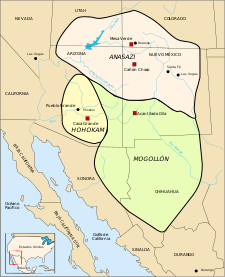
Archaeologists identify the first people in the broader San Juan Basin as hunter-gatherers designated as the Archaic; they in turn descended from nomadic Clovis hunters who arrived in the Southwest around 10,000 B.C.E. By approximately 900 B.C.E., these people lived at sites such as Atlatl Cave. The Archaic people left very little evidence of their presence in Chaco Canyon itself. However, by approximately AD 490, their descendants, designated as Basketmakers, were continuously farming within the canyon, living in Shabik'eshchee Village and other pithouse settlements.
A small population of Basketmakers remained in the Chaco Canyon area and developed through several cultural stages until around 800, when they were building crescent-shaped stone complexes, each comprising four to five residential suites abutting subterranean kivas, large enclosed areas set aside for religious observances and ceremonies. These structures have been identified as characteristic of the Early Pueblo People. By 850, the Pueblo population—also known as the "Anasazi," from a Navajo term meaning "ancient enemy"—had rapidly expanded, with members residing in larger, denser pueblos. There is strong evidence of a canyon-wide turquoise processing and trading industry dating from the 10th century. At this time, the first section of the massive Pueblo Bonito complex was built, beginning with a curved row of 50 rooms near its present north wall
The cohesive system that characterized Chacoan society began disintegrating around 1140, perhaps in response to a severe 50-year drought that began in 1130; chronic climatic instability, including a series of severe droughts, again struck the region between 1250 and 1450. Other factors included water management patterns (leading to arroyo cutting) and deforestation. For instance, timber for construction was imported from outlying mountain ranges, such as the Chuska Mountains over 50 miles (80 km) to the west. Outlying communities began to disappear and, by the end of the century, the buildings in the central canyon had been carefully sealed and abandoned. Archaeological and cultural evidence leads scientists to believe people from this region migrated south, east, and west into the valleys and drainages of the Little Colorado River, the Rio Puerco, and the Rio Grande.
Athabaskan succession
Numic-speaking peoples, such as the Ute and Shoshone, were present on the Colorado Plateau beginning in the 12th century. Nomadic Southern Athabaskan speaking peoples, such as the Apache and Navajo, succeeded the Pueblo people in this region by the 15th century; in the process, they acquired Chacoan customs and agricultural skills. Ute tribal groups also frequented the region, primarily during hunting and raiding expeditions. The modern Navajo Nation lies west of Chaco Canyon, and many Navajo (more appropriately known as the Diné) live in surrounding areas. The arrival of the Spanish in the 17th century inaugurated an era of subjugation and rebellion, with the Chaco Canyon area absorbing Puebloan and Navajo refugees fleeing Spanish rule. In succession, as first Mexico, then the U.S., gained sovereignty over the canyon, military campaigns were launched against the region's remaining inhabitants.
Excavation and protection
The trader Josiah Gregg was, in 1832, the first to write about the ruins of Chaco Canyon, referring to Pueblo Bonito as "built of fine-grit sandstone." In 1849, a U.S. Army detachment passed through and surveyed the ruins. The location was so remote, however, that over the next 50 years the canyon was scarcely visited. After a brief reconnaissance by Smithsonian scholars in the 1870s, formal archaeological work began in 1896, when a party from the American Museum of Natural History (the Hyde Exploring Expedition) began excavating in Pueblo Bonito. They spent five summers in the region, sent over 60,000 artifacts back to New York, and operated a series of trading posts.
In 1901 Richard Wetherill, who worked for the Hyde brothers and their expedition, claimed a homestead of 161 acres of land that included Pueblo Bonito, Pueblo del Arroyo, and Chetro Ketl While investigating Wetherill's land claim, federal land agent Samuel J. Holsinger reported the physical setting of the canyon and the sites, noted prehistoric road segments and stairways above Chetro Ketl, and documented prehistoric dams and irrigation systems. His report (which went unpublished) strongly recommended the creation of a national park to encompass and preserve Chacoan sites. The next year, Edgar Lee Hewett, who was president of New Mexico Normal University (which later became New Mexico Highlands University), mapped many Chacoan sites. Hewett and others helped to enact the Federal Antiquities Act of 1906, which was the first U.S. law protecting antiquities; it was, in effect, a direct consequence of controversy surrounding Wetherill's activities in the Chaco Canyon area. The Act also allowed the President to establish national monuments. President Theodore Roosevelt thus proclaimed Chaco Canyon National Monument on March 11, 1907; Wetherill relinquished his claim on several parcels of land he held in Chaco Canyon.
In 1949, Chaco Canyon National Monument was expanded with lands deeded from the University of New Mexico. In return, the university maintained scientific research rights to the area. By 1959, the National Park Service had constructed a park visitor center, staff housing, and campgrounds. As a historic property of the National Park Service, the National Monument was listed on the National Register of Historic Places on October 15, 1966. In 1971, researchers Robert Lister and James Judge established the Chaco Center, a division for cultural research that functioned as a joint project between the University of New Mexico and the National Park Service. A number of multi-disciplinary research projects, archaeological surveys, and limited excavations began during this time. The Chaco Center extensively surveyed the Chacoan roads, well-constructed paths radiating from the central canyon. The results from such research conducted at Pueblo Alto and other sites dramatically altered accepted academic interpretations of both the Chacoan culture and the Four Corners region of the American Southwest.
The richness of the cultural remains at park sites led to the expansion of the small National Monument into the Chaco Culture National Historical Park on December 19, 1980, when an additional 13,000 acres (53 km²) were added to the protected area. In 1987, the park was designated a World Heritage Site by UNESCO. To safeguard Chacoan sites on adjacent Bureau of Land Management and Navajo Nation lands, the Park Service developed the multi-agency Chaco Culture Archaeological Protection Site program. These initiatives have detailed the presence of more than 2,400 archeological sites within the current park's boundaries; only a small percentage of these have been excavated.
Sites
The Chacoans built their complexes along a nine-mile (14 km) stretch of canyon floor, with the walls of some structures aligned cardinally and others aligned with the 18.6-year cycle of minimum and maximum moonrise and moonset. Nine Great Houses are positioned along the north side of Chaco Wash, at the base of massive sandstone mesas. Other Great Houses are found on mesa tops or in nearby washes and drainage areas. There are 14 recognized Great Houses, which are grouped below according to geographic positioning with respect to the canyon.
Central canyon
The central portion of the canyon contains the largest Chacoan complexes. The most studied is Pueblo Bonito ("Beautiful Village"); covering almost 2 acres (8,000 m²) and comprising at least 650 rooms, it is the largest Great House; in parts of the complex, the structure was four stories high. The builders' use of core-and-veneer architecture and multi-story construction necessitated massive masonry walls up to 3 feet (1 m) thick. Pueblo Bonito is divided into two sections by a wall precisely aligned to run north-south, bisecting the central plaza. A Great Kiva was placed on either side of the wall, creating a symmetrical pattern common to many Chacoan Great Houses. The complex, upon completion, was roughly the size of the Roman Colosseum.
Nearby is Pueblo del Arroyo; founded between AD 1050 and 1075 and completed in the early 12th century, it is located near Pueblo Bonito at a drainage outlet known as South Gap. Casa Rinconada, hosting a Great Kiva and relatively isolated from other sites in Chaco Canyon, sits to the south side of Chaco Wash, adjacent to a Chacoan road leading to a set of steep stairs that reached the top of Chacra Mesa. The kiva stands alone, with no residential or support structures; it once had a 39-foot (12 m) passageway leading from the underground kiva to several above-ground levels. Chetro Ketl, located near Pueblo Bonito, bears the typical D-shape of many other central complexes, but is slightly smaller. Begun between AD 1020 and 1050, its 450–550 rooms shared just one Great Kiva. Scientists estimate that it took 29,135 person-hours of construction to erect Chetro Ketl alone; Hewett estimated that it required the wood of 5,000 trees and 50 million stone blocks.
Kin Kletso ("Yellow House") was a medium-sized complex located 0.5 miles (0.8 km) west of Pueblo Bonito; it shows strong evidence of construction and occupation by Pueblo peoples from the northern San Juan Basin. Its rectangular shape and design is related to the Pueblo II cultural group, rather than the Pueblo III style or its Chacoan variant. It contains around 55 rooms, four ground-floor kivas, and a two-story cylindrical tower that may have functioned as a kiva or religious center. Evidence of an obsidian production industry was discovered near the village, which was erected between AD 1125 and 1130.
Pueblo Alto, a Great House of 89 rooms, is located on a mesa top near the middle of Chaco Canyon, and is 0.6 miles (1 km) from Pueblo Bonito; it was begun between AD 1020 and 1050 during a wider building boom throughout the canyon. Its location made the community visible to most of the inhabitants of the San Juan Basin; indeed, it was only 2.3 miles (3.7 km) north of Tsin Kletsin, on the opposite side of the canyon. The community was the center of a bead- and turquoise-processing industry that influenced the development of all villages in the canyon; chert tool production was also common. Research conducted by archaeologist Tom Windes at the site suggests that only a handful of families, perhaps as few as five to twenty, actually lived in the complex; this may imply that Pueblo Alto served a primarily non-residential role. Another Great House, Nuevo Alto, was built on the north mesa near Pueblo Alto; it was founded in the late 1100s, a time when the Chacoan population was declining in the canyon.
Outliers
In Chaco Canyon's northern reaches lies another cluster of Great Houses; among the largest are Casa Chiquita ("Small House"), a village built in the 1080s AD, when, in a period of ample rainfall, Chacoan culture was expanding. Its layout featured a smaller, squarer profile; it also lacked the open plazas and separate kivas of its predecessors. Larger, squarer blocks of stone were used in the masonry; kivas were designed in the northern Mesa Verdean tradition. Two miles down the canyon is Peñasco Blanco ("White Bluff"), an arc-shaped compound built atop the canyon's southern rim in five distinct stages between AD 900 and 1125. A cliff painting (the "Supernova Platograph") nearby may record the sighting of the SN 1054 supernova on July 5, 1054.
Hungo Pavi, located just 1 mile (2 km) from Una Vida, measured 872 feet (266 m) in circumference. Initial explorations revealed 72 ground-level rooms, with structures reaching four stories in height; one large circular kiva has been identified. Kin Nahasbas (built in either the 9th or 10th century) was another major ruin; it is located slightly north of Una Vida, positioned at the foot of the north mesa. Limited excavation has been conducted in this area.
Tsin Kletzin ("Charcoal Place"), a compound located on the Chacra Mesa and positioned above Casa Rinconada, is 2.3 miles (3.7 km) due south of Pueblo Alto, on the opposite side of the canyon. It lies near Weritos Dam, a massive earthen structure that scientists believe provided Tsin Kletzin with all of its domestic water. The dam worked by retaining stormwater runoff in a reservoir. However, massive amounts of silt accumulated during flash floods would have forced the residents to regularly rebuild the dam and dredge the catchment area.
Deeper into the canyon, Una Vida ("One Life") is one of the three earliest Great Houses with construction beginning around AD 900. Comprising at least two stories and 124 rooms, it shares an arc or D-shaped design with its contemporaries, Peñasco Blanco and Pueblo Bonito, but has a unique "dog leg" addition made necessary by topography. It is located in one of the canyon's major side drainages, near Gallo Wash, and was massively expanded after 930. Wijiji ("Greasewood"), comprising just over 100 rooms, is the smallest of the Great Houses. Built between AD 1110 and 1115, it was the last Chacoan Great House to be constructed. Somewhat isolated within the narrow wash, it is positioned 1 mile (2 km) from neighboring Una Vida.
Directly north are communities that are even more remote, including Salmon Ruins and Aztec Ruins, which are located along the San Juan and Animas Rivers near Farmington; these were built during a 30-year wet period that began in AD 1100. Sixty miles (100 km) directly south of Chaco Canyon, on the Great South Road, lies another cluster of outlying communities. The largest of these is Kin Nizhoni, which stands atop a 7,000 foot (2,100 m) mesa surrounded by marsh-like bottomlands.
Ruins
Great Houses
Immense complexes known as "Great Houses" were key centers exemplifying Chacoan architectural and worship styles. Although forms evolved as the centuries passed, the houses maintained several core characteristics. Most notable is their sheer bulk; most complexes in Chaco Canyon averaged more than 200 rooms each, with some reaching up to 700 rooms. The sizes of individual rooms were also substantial, with high ceilings when compared to buildings erected in preceding Anasazi periods. They were also well-planned, with vast sections or wings erected in a single stage, rather than in increments. Houses are generally oriented to face the south, with plaza areas almost always enclosed by edifices of sealed-off rooms or high walls. The predominantly multistory constructions often stood four to five stories tall, with single-story rooms facing directly onto the plaza; room blocks were terraced so that the tallest sections composed the pueblo's rear edifice. Rooms were often organized into suites, with front rooms larger than rear, interior, and storage rooms or areas.
Ceremonial structures known as kivas were built in proportion to the number of rooms in a pueblo. On average, one small kiva was built for every 29 rooms. Nine complexes also each hosted an oversized Great Kiva, which could range up to 63 feet (19 m) in diameter. All Chacoan kivas share distinctive architectural features, including T-shaped doorways and stone lintels. Though simple and compounds walls were also built, Great Houses were primarily constructed of core-and-veneer walls: two parallel load-bearing walls comprising dressed, flat sandstone blocks bound in clay mortar were erected. The gap between the walls was filled with rubble, which then formed the wall's core. Walls were then covered in a veneer of small sandstone pieces, which were pressed into a layer of binding mud. These surfacing stones were often placed to create distinctive patterns. Taken together, the Chacoan constructions required the wood of over 200,000 coniferous trees, which were mostly hauled—on foot—from mountain ranges up to 70 miles (113 km) away.
Usage
The meticulously designed buildings characterizing the larger Chacoan complexes did not emerge until around AD 1030. The Chacoan people combined pre-planned architectural designs, astronomical alignments, geometry, landscaping, and engineering to create an ancient urban center of unique public architecture. Researchers have concluded that the complex may have had a relatively small residential population, with larger groups assembling only temporarily for annual events and ceremonies. Smaller sites, apparently more residential in character, are scattered near the Great Houses in and around Chaco Canyon. The canyon itself runs along one of the lunar alignment lines, suggesting the location was originally chosen for its astronomical significance. If nothing else, this facilitated alignment with several other key structures in the canyon.
Around this time, the extended Ancestral Puebloan (Anasazi) community also experienced a population and construction boom. Throughout the 10th century, Chacoan construction techniques gradually spread from the canyon to neighboring regions. By AD 1115, at least 70 outlying pueblos with characteristic Chacoan architecture had been built within the 25,000 square miles (65,000 sq. km) that compose the San Juan Basin. Researchers debate the function of the buildings, some of which are large enough to be considered Great Houses in their own right. Some suggest they may have been more than agricultural communities, perhaps functioning as trading posts or ceremonial sites.
Thirty such outliers spread across 65,000 square miles (168,000 sq. km) are connected to the central canyon and to one another by a web of six enigmatic Chacoan road systems. Extending up to 60 miles (97 km) in generally straight lines, they appear to have been extensively surveyed and engineered. They typically feature depressed and scraped caliche beds approximately 30 feet (9 m) wide; earthen berms or rocks, at times composing low walls, defined their edges. When necessary, the roads used steep stone stairways and rock ramps to traverse major obstacles, such as cliffs. Although their overall function may never be known, archaeologist Harold S. Gladwin reported that, according to the beliefs of nearby Navajo, the Anasazi had used the roads for transporting timber; archaeologist Neil Judd offered a similar hypothesis.
Activities
Hiking
- The Pueblo Alto Trail is a popular 5.4-mile (8.7-km) loop trail that leads to the Pueblo Alto and New Alto, with its twenty-eight rooms and one kiva. This trail also allows outstanding overlooks of Pueblo Bonito, which had five stories and up to six hundred rooms.
- The Penasco Blanco Trail is 6.4 miles (10.3 km) and leads to Pueblo Bonito, one of the earliest pueblos in the canyon. Petroglyphs can be seen on the canyon wall.
- The Wijiji Trail is 3.0 miles (4.8 km) leads to the Wijiji pueblo built with exceptional symmetry around AD 1100.
- The South Mesa Trail is 3.0 miles (4.8 km) and leads the hiker 100 feet higher than any other point along the canyon trails. There is an abundant array of wilflowers seen here in the spring and summer.
Biking
- Wijiji Trail is 3.0 miles (4.8 km) and follows the old Sargent Ranch road up the north side of Chaco Wash.
- Kin Klizhin is 23.8 miles (38 km) and follows U.S. Highway 57 south along Navajo Tribal land.
Camping
- Gallo Campground is located just one mile east of the Visitor Center and open year-round.
Stargazing
Open from April to October, the Chaco Night Sky Program presents astronomy programs and telescope viewing of the spectacular dark night sky. Nothing attaches us to the past more than gazing at the same brilliant constellations as our ancestors.
Sources and further reading
- Brugge, D, Hayes, A & Judge, W (1988), Archeological Surveys of Chaco Canyon, New Mexico, University of New Mexico Press, ISBN 0-82631-029-X.
- Diamond, J (2005), Collapse: How Societies Choose to Fail or Succeed, Viking, ISBN 0-670-03337-5.
- Fagan, B (2005), Chaco Canyon: Archaeologists Explore the Lives of an Ancient Society, Oxford University Press, ISBN 0-19-517043-1.
- Fagan, B (1998), From Black Land to Fifth Sun: The Science of Sacred Sites, Basic Books, ISBN 0-20-195991-7.
- Frazier, K (2005), People of Chaco: A Canyon and Its Culture, Norton, ISBN 0-393-30496-5.
- Hopkins, RL (2002), Hiking the Southwest's Geology: Four Corners Region, Mountaineers, ISBN 0-89886-856-4.
- Kelley, DH & Milone, EF (2004), Exploring Ancient Skies: An Encyclopedic Survey of Archaeoastronomy, Springer, ISBN 0-38795-310-8.
- National Park Service (2005), United States World Heritage Periodic Report: Chaco Culture National Historical Park (Section II) [Retrieved June 20, 2007].
- National Park Service (2007), Chaco Culture National Historical Park [Retrieved June 20, 2007].
- Noble, D (1984), New Light on Chaco Canyon, School of American Research Press, ISBN 0-933452-10-1.
- Noble, D (1991), Ancient Ruins of the Southwest: An Archaeological Guide, Northland, ISBN 0-87358-530-5.
- Reynolds, A, Betancourt, J & Quade, J et al (2005), "87Sr/86Sr sourcing of ponderosa pine used in Anasazi Great House construction at Chaco Canyon, New Mexico", Journal of Archaeological Science, vol. 32: 1061–1075 [Retrieved June 20, 2007].
- Sofaer, A (1997), The Primary Architecture of the Chacoan Culture: A Cosmological Expression, University of New Mexico Press [Retrieved June 20, 2007].
- Sofaer, A (1999), The Mystery of Chaco Canyon, South Carolina ETV.
- Strutin, M (1994), Chaco: A Cultural Legacy, Southwest Parks and Monuments Association, ISBN 1-877856-45-2.
- Stuart, D (2000), Anasazi America, University of New Mexico Press, ISBN 0-826321-79-8.
- Plog, S (1998), Ancient Peoples of the American Southwest, Thames and London, ISBN 0-500-27939-X.
External links
- Chaco Culture National Historical Park. National Park Service. Retrieved February 16, 2007.
- Chaco Digital Initiative. University of Virginia. Retrieved January 7, 2007.
- Ancient Observatories: Chaco Canyon. Exploratorium. Retrieved February 16, 2007.
- The Mystery of Chaco Canyon. Solstice Project. Retrieved February 16, 2007.
- Traditions of the Sun: Chaco Canyon National Historical Park. University of California. Retrieved February 16, 2007.
| National Historical Parks of the United States | |
|---|---|
| Adams • Appomattox Court House • Boston • Cane River Creole • Cedar Creek and Belle Grove • Chaco Culture • Chesapeake and Ohio Canal • Colonial • Cumberland Gap • Dayton Aviation Heritage • George Rogers Clark • Harpers Ferry • Hopewell Culture • Independence • Jean Lafitte • Kalaupapa • Kaloko-Honokohau • Keweenaw • Klondike Gold Rush • Lewis and Clark • Lowell • Lyndon B. Johnson • Marsh-Billings-Rockefeller • Minute Man • Morristown • Natchez • New Bedford Whaling • New Orleans Jazz • Nez Perce • Pecos • Pu'uhonua o Honaunau • Rosie the Riveter/World War II Home Front • Salt River Bay • San Antonio Missions • San Francisco Maritime • San Juan Island • Saratoga • Sitka • Tumacácori • Valley Forge • War in the Pacific • Women's Rights |
Cahokia | Carlsbad Caverns | Chaco Culture | Everglades | Grand Canyon | Great Smoky Mountains | Hawaii Volcanoes | Independence Hall | Kluane / Wrangell-St. Elias / Glacier Bay / Tatshenshini-Alsek (w/ Canada) | La Fortaleza and San Juan National Historic Site, Puerto Rico | Mammoth Cave | Mesa Verde | Monticello and University of Virginia | Olympic | Pueblo de Taos | Redwood | Statue of Liberty | Waterton Glacier International Peace Park (w/ Canada) | Yellowstone | Yosemite
Credits
New World Encyclopedia writers and editors rewrote and completed the Wikipedia article in accordance with New World Encyclopedia standards. This article abides by terms of the Creative Commons CC-by-sa 3.0 License (CC-by-sa), which may be used and disseminated with proper attribution. Credit is due under the terms of this license that can reference both the New World Encyclopedia contributors and the selfless volunteer contributors of the Wikimedia Foundation. To cite this article click here for a list of acceptable citing formats.The history of earlier contributions by wikipedians is accessible to researchers here:
The history of this article since it was imported to New World Encyclopedia:
Note: Some restrictions may apply to use of individual images which are separately licensed.

